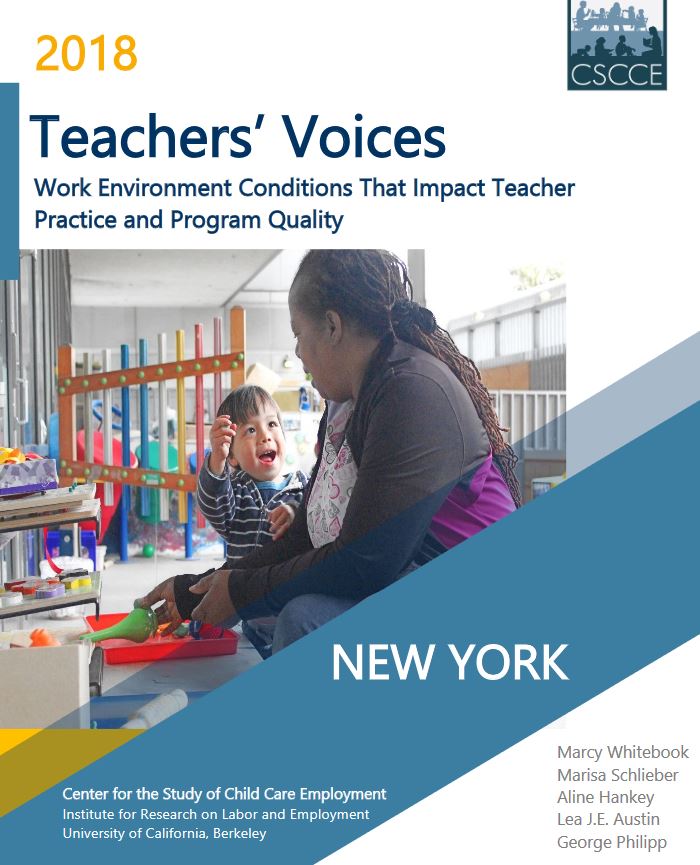The New York Early Childhood Professional Development Institute is committed to building a system that supports the early childhood workforce. Capturing teacher voices, understanding their professional and career development needs, and sharing key information to help policy makers ensures that we nurture a highly effective workforce. QUALITYstarsNY, the state’s Quality Rating and Improvement System for early learning programs, also places considerable emphasis on the early childhood workforce, investing extensive resources to support program leadership and teaching staff.
Recently, the Institute partnered with researchers at the Center for the Study of Child Care Employment (CSCCE) at the University of California, Berkeley to study teachers’ work environments in QUALITYstarsNY programs. We were interested in comparing CSCCE’s Supportive Environmental Quality Underlying Adult Learning (SEQUAL) tool with QUALITYstarsNY Standards and ratings to determine whether center-based programs with high QUALITYstarsNY ratings would also score highly on SEQUAL.
This was important to us because SEQUAL measures five critical areas of the program environment that are essential for teachers to educate and nurture our young children: teaching supports, the learning community, job-crafting, adult well-being, and program leadership. In addition to providing rich data about QUALITYstarsNY and the way it successfully supports early childhood programs in New York State, we received other data about the workforce that contribute to a greater debate about the changes that need to be made to the system – locally, regionally and nationally.
In this post, we share some of the findings from the resulting CSCCE report, Teachers’ Voices: Work Environment Conditions That Impact Teacher Practice and Program Quality – New York, that relate to New York’s workforce, their compensation, and their well-being:
- Predictably, 96% of the workforce in the study sample were female.
- The average age of the study participants was 41.
- Older teaching staff were more likely to work in Four-Star and Five-Star (higher quality) centers.
- Of teaching staff working in New York City, 61% were people of color.
Here are other key findings that we need to pay attention to:
- 40% of teaching staff in the study resided in families that utilized at least one form of federal public support. Even 20% of teachers with bachelor’s degrees or higher resided in families that utilized at least one form of federal public support.
- Almost half the teachers in the sample have student loan debt: 52% of these teachers had loans in excess of $25,000 and 24% had loans in excess of $50,000.
- Early childhood teaching staff with bachelor’s degrees in the study earned just $14 an hour, a stark contrast to data that show kindergarten teachers in the state earn $41.19 an hour.
In the questions about adult well-being, we see that our teachers are stressed about paying for their basic living expenses:
- 70% of teaching staff reported worrying about paying housing costs.
- One-half of the teaching staff reported that they worry about paying for daily expenses, including transportation to and from work.
- 78% of teaching staff reported worrying about having enough to pay their family’s monthly bills.
- 70% reported that they worry about paying for their household’s routine health care costs.
- 50% of teaching staff worry about having enough food to feed their family on a monthly basis.
- 75% reported uncertainty about not getting a raise.
- Nearly all teaching staff (89%) agreed or somewhat agreed that they worry about having enough savings for retirement.
These findings tell a dismal story about our failings, as a society, to value the work we know is critical to every community’s well-being. National polls tell us that high-quality early childhood education is a bi-partisan issue. People across the country, and certainly across New York, acknowledge how important early childhood programs are to their own children’s futures and to bolster the economy. People who have high-quality child care are better able to work and/or study, improving their career prospects. But how much longer can we sustain an early childhood system where we take so much from our educators and give so little in return? What will it take to stabilize and strengthen our workforce? What will it take to place a true value on every educator’s work and pay them accordingly? What prevents us from providing the same health care and comprehensive benefit packages that most employees have across this country?
The United States has solved far more complex problems than this. And rarely do we find ourselves with a problem to solve that already has ample evidence to demonstrate that, when adequate investments are made, there is a guaranteed return. There is really no more time to screw around – it is time to just make our young children and their families a priority and allocate the appropriate amount of funds to create the system we know we need.
Sherry M. Cleary
Executive Director
